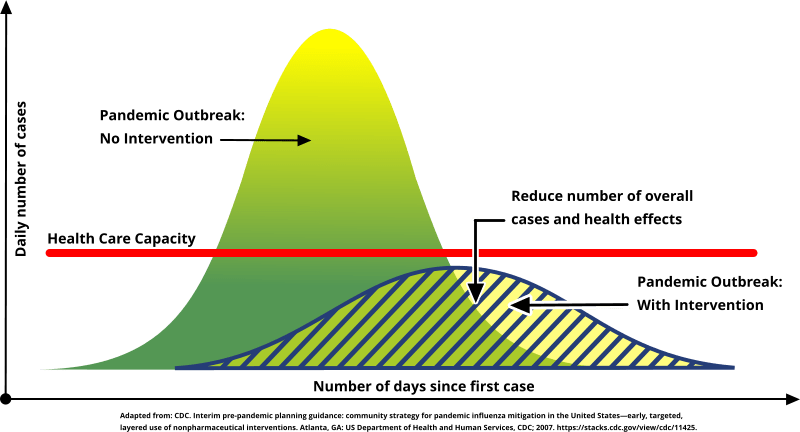Flattening of Curve in Simplified Term
Flattening of Curve : Novel corona virus, covid-19 started in Wuhan and policy adopted by Chinese authorities of quarantine and isolation. Terms belonging to epidemiology is now everywhere and one of this Term flattening of curve is often heard and interpreted in different ways.
Flattening of curve is not a new terminology and is present in epidemiology perhaps through first decade of this century. (Google could not answer query of when and who started using this term, so as I)
For an infectious disease which is unknown hitherto, spreads and no cure or vaccine is available. Scientists (Epidemiologists) devised a unique strategic measure, that is to reduce rate of transmission, or break chain of transmission. This does not necessarily reduce number of cases but simply means cases will present over longer time period. Means cases are spread over time axis.
With virus like corona which is now known to cause human to human transmission and have very long survival time in human along with higher mortality rate. If infection is let to spread relentlessly, a geography will see very high number of cases on a very single day. By taking measures to flatten curve may benefit in number of ways.
- Number of cases seen on single day are reduced. So that healthcare system can take the burden.
- Time is borrowed to understand nature, modes of transmission, vaccine preparation and if any cure is obtained in borrowed time.
- By limiting number of cases even if no direct remedy is available, outcome can be improved by providing better supportive managements.
- Sudden spike in number of cases with diseases with higher mortality rates can lead to chaos everywhere. Which is very much reduced by information gradually imbibed by masses and people slowly learn to live with disease and understand limitation of science, society and governments.
Cons :
There may be cons as raised by many thinkers
- When an infectious disease spreads fast many people in community develop simultaneous infections and herd immunity* is achieved fast. So pandemic clears faster. (Steeper is upward spike, steep is downward spike)
- Disease will remain for longer time in community, and measure taken to flatten the curve can slow down economic growth.
- Infectious microorganisms tend to mutant, and there is small increase in possibilities of mutant variation leading to new wave of disease.
Historic Evidences :-
Favour of Flattening of curve.
Classic example is Spanish flu in two cities of America in 1918, That is Philadelphia and St. Louis, Philadelphia ignored social distancing saw 16000 deaths while same time St. Louis observed social distancing and saw 2000 deaths only.
Our experience with present epidemic of covid-19 itself telling success of measures taken to flatten the curve. If we compare two countries, Italy and Germany, we see major difference in death rate of two countries. While Italy saw steep spike and on other hand Germany saw infection with flattened spike. Difference in mortality rate of two countries is more than twice.
Ways to flatten the curve –
Means decreasing rate of transmission of infection. In simpler words reducing spread of passing of disease causing organism from one person to another.
It depends on mode of transmission of diseases causing organism. In present scenario of novel covid-19 transmission through air droplet is well known. These droplets are saliva droplets which contain virus particle. We know that
- These droplets are released when one person speaks, sneeze or cough.
- These droplets spreads 1 mtr to 3 mtr(different studies) before settling on ground and
- They survive for some time on different surfaces.
Now as these droplets can be inhaled by another individual, or when touched or come in contact of skin of uninfected person. He may unknowingly transmit these to nostrils, eyes or mouth of himself.
So to flatten curve for novel covid-19 strategy of
- Wearing mask (Avoid spread of droplets as some one speaks, sneeze or cough and avoid inhalation)
- Social distancing (Spread of virus in most cases 1 mtr so maintain distance from person to person)
- Repeated handwashing (So when you unknowingly touch, some surface harboring virus containing droplets, they can be wiped and destroyed.
- Lock down : To reduce gathering, crowding in places like railway stations, closed spaces like malls, theatres, Offices, Factories, class rooms Buses etc.
It is individuals, community’s, authorities and administrator’s thinking to what they give priority, economy and their long term effects or healthcare and their long term effects. Many countries are observing strict lock down, some partial and some not at all.
What is exactly right and what is exactly wrong no one can say.
We can only wish and pray that peace and prosperity prevail.
Contact nueradr team for any suggestiongs or query.

